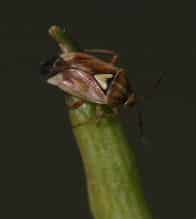Lygus. There is no threshold before early flowering or flowering as damage at this point is not economical. Research shows that low-level lygus feeding at flowering can actually stimulate yield. The only situation where spraying may be warranted at flowering stages is if numbers are so high that large areas of the crop are not coming into flower because flowers are being eaten. Lygus thresholds apply to the pod stages when feeding can cost yield and the plant cannot compensate with continued flowering. Read more.

Cabbage seedpod weevil. Weevils do their most economic damage by laying eggs into small pods. Those eggs then hatch into larvae that eat the seeds. Therefore insecticides should be applied only after first pods reach 3/4” long and if numbers are 20-40 per 10 sweeps. Before making a final decision, check various locations throughout the field, not just the borders. Read more.
Bertha armyworm. Most regions across the Prairies are reporting a low risk (fewer than 300 moths in traps throughout the season) at this point. Some Manitoba sites (Benito and Minto) have numbers in the “uncertain risk” range. One Saskatchewan site at Watrous exceeded 600, which is still not high risk. Alberta’s map currently shows no areas above “low” risk. While moth trap counts cannot pinpoint the risk for all fields, they can determine areas where monitoring for larvae should be given greater importance. See the Prairie Pest Monitoring Network for links to the provincial monitoring results.
Don’t spray bertha moths. Manitoba Ministry of Agriculture provincial entomologist John Gavloski answers the question “Is there any merit to tank mixing an insecticide with a fungicide application for sclerotinia to try to control adults or eggs of bertha armyworm and hence prevent possibly managing larvae later?” in his June 29 report. He writes….
The short answer to this is no, for the following reasons:
—Adult emergence and egg laying can be quite prolonged. This reduces the odds of decent kill of adult or eggs.
—Eggs are laid on the underside of leaves, where getting lethal doses to the eggs could have little success.
—There is possible harm to beneficial insects. With some insecticides this includes pollinators, predators and parasitoids, while for the most selective insecticide option harm to beneficial insects is limited to some generalist predators. Regardless, this consequence needs to be factored in.
—The purpose of the trap counts and forecasts for bertha armyworm and diamondback moth is to try to help prioritize scouting for larvae where management thresholds exist. Research data does not exist to back using trap counts as a tool to make management decisions. So in this case, using trap data to make management decisions is counter to integrated pest management principals (such as using insecticides only when established thresholds have been exceeded) that such forecasting is trying to enhance.
—Some insecticides can only be applied once to canola. An insecticide application to target the adult or egg stages of bertha armyworm, where success is questionable, may mean the insecticide is not an option later should larvae become a problem. So best to target the stage where successful control is more likely.
—And then there is the economics: applications with questionable results have a higher probability of losing you money instead of adding to your income.
Swede midge. While swede midge continues to expand its territory in Western Canada, numbers and damage levels have remained low, in general. However, that could change quickly, based on the Ontario experience. Flowering is a good time to scout. Look for larvae inside florets, and for blackening and scarring of floret tissue typical of larval damage. What to look for? If you find these “springing” larvae, contact your provincial entomologist or CCC agronomist.
Diamondback moth. Keep them on your scouting list, even if damage has not been high the past few years. It takes 200-300 larvae per square metre to cause economic damage at the pod stage. It seems beneficial insects are helping to keep diamondback numbers below economic thresholds, but flare ups are possible. Read more.
